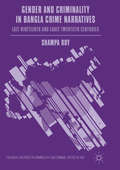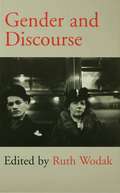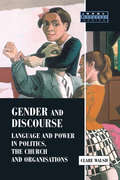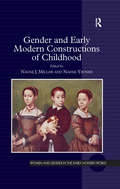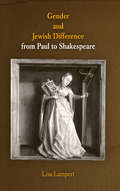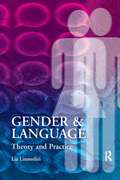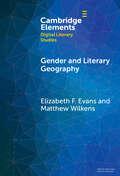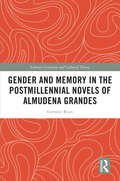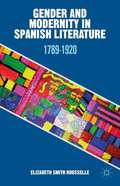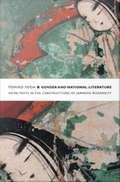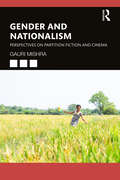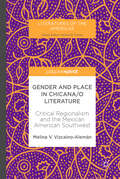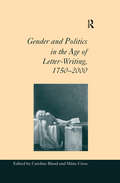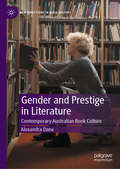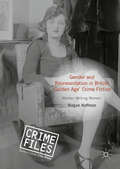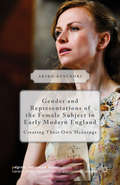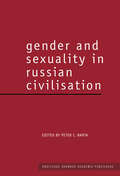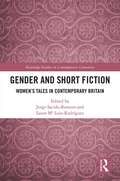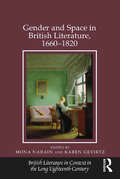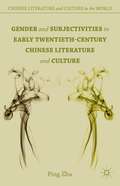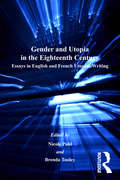- Table View
- List View
Gender and Criminality in Bangla Crime Narratives
by Shampa RoyThis book examines diverse literary writings in Bangla related to crime in late nineteenth and early twentieth century colonial Bengal, with a timely focus on gender. It analyses crime-centred fiction and non-fiction in the region to see how actual or imagined crimes related to women were shaped and fashioned into images and narratives for contemporary genteel readers. The writings have been examined within a social-historical context where gender was a fiercely contested terrain for publicly fought debates on law, sexual relations, reform, and identity as moulded by culture, class, and caste. Both canonized literary writings (like those of Bankim Chatterji) as well as non-canonical, popular writings (of writers who have not received sufficient critical attention) are scrutinised in order to examine how criminal offences featuring women (as both victims and offenders) have been narrated in early manifestations of the genre of crime writing in Bangla. An empowered and thought-provoking study, this book will be of special interest to scholars of criminology and social justice, literature, and gender.
Gender and Discourse
by Ruth WodakThe contributors to this collection offer an essential introduction to the ways in which feminist linguistics and critical discourse analysis have contributed to our understanding of gender and sex. By examining how these perspectives have been applied to these concepts, the contributors provide both a review of the literature, as well as an opportunity to follow the most recent debates in this area. Gender and Discourse brings together European, American and Australian traditions of research. Through an analysis of a range of `real' data, the contributors demonstrate the relevance of these theoretical and methodological insights for gender research in particular and social practice in general.
Gender and Discourse: Language and Power in Politics, the Church and Organisations (Real Language Series)
by Clare WalshReal Language Series General Editors:Jennifer Coates, Jenny Cheshire, Euan Reid This is a sociolinguistics series about the relationships between language, society and social change. Books in the series draw on natural language data from a wide range of social contexts. The series takes a critical approach to the subject, challenging current orthodoxies, and dealing with familiar topics in new ways. Gender and Discourse offers a critical new approach to the study of language and gender studies. Women moving into the public domains of power traditionally monopolised by men are creating new identities for themselves, and the language that is used by them and about them offers an insight into gender roles. Clare Walsh reviews the current dominance/difference debates, and proposes a new analytical framework which combines the insights of critical discourse and feminist perspectives on discourse to provide a new perspective on the role of women in public life. A superbly accessible book designed for students and researchers in the field, the book features: - topical case studies from the arenas of politics, religion and activism- a new analytical framework, also summarised in chart form so the reader can apply their own critical analyses of texts. - written and visual text types for the reader's own linguistic and semiotic analysis. 'This important book takes up a neglected question in the study of language and gender - what difference women make to the discourse of historically male-dominated institutions - and brings to bear on it both the insights of feminist scholarship and evidence from women's own testimony. Clare Walsh's analysis of the dilemmas women face is both subtle and incisive, taking us beyond popular 'Mars and Venus' stereotypes and posing some hard questions for fashionable theories of language, identity and performance.
Gender and Early Modern Constructions of Childhood: Figuring Caregiving In The Early Modern Period (Women and Gender in the Early Modern World)
by Naomi J. MillerDrawing on art history, literary studies and social history, the essays in this volume explore a range of intersections between gender and constructions of childhood in the 15th, 16th and 17th centuries in Italy, England, France and Spain. The essays are grouped around the themes of celebration and loss, education and social training, growing up and growing old. Contributors grapple with ways in which constructions of childhood were inflected by considerations of gender throughout the early modern world. In so doing, they examine representations of children and childhood in a range of sources from the period, from paintings and poetry to legal records and personal correspondence. The volume sheds light on some of the ways in which, in the relations between Renaissance children and their parents and peers, gender mattered. Gender and Early Modern Constructions of Childhood enriches our understanding of individual children and the nature of familial relations in the early modern period, as well as of the relevance of gender to constructions of self and society.
Gender and Genre in the Folklore of Middle India (Myth and Poetics)
by Joyce Burkhalter FlueckigerIn Gender and Genre in the Folklore of Middle India, Joyce Burkhalter Flueckiger analyzes six representative Indian folklore genres from a single regional repertoire to show the influence of their intertextual relations on the composition and interpretation of artistic performance. Placing special emphasis on women’s rituals, she looks at the relationship between the framework and organization of indigenous genres and the reception of folklore performance. The regional repertoire under examination presents a strikingly female-centered world. Female performers and characters are active, articulate, and frequently challenge or defy expectations of gender. Men also confound traditional gender roles. Flueckiger includes the translations of two full performance texts of narratives sung by female and male storytellers respectively.
Gender and Jewish Difference from Paul to Shakespeare
by Lisa LampertAlthough representations of medieval Christians and Christianity are rarely subject to the same scholarly scrutiny as those of Jews and Judaism, "the Christian" is as constructed a term, category, and identity as "the Jew." Medieval Christian authors created complex notions of Christian identity through strategic use of representations of Others: idealized Jewish patriarchs or demonized contemporary Jews; Woman represented as either virgin or whore. In Western thought, the Christian was figured as spiritual and masculine, defined in opposition to the carnal, feminine, and Jewish.Women and Jews are not simply the Other for the Christian exegetical tradition, however; they also represent sources of origin, as one cannot conceive of men without women or of Christianity without Judaism. The bifurcated representations of Woman and Jew found in the literature of the Middle Ages and beyond reflect the uneasy figurations of women and Jews as both insiders and outsiders to Christian society.Gender and Jewish Difference from Paul to Shakespeare provides the first extended examination of the linkages of gender and Jewish difference in late medieval and early modern English literature. Focusing on representations of Jews and women in Chaucer's Canterbury Tales, selections from medieval drama, and Shakespeare's Merchant of Venice, Lampert explores the ways in which medieval and early modern authors used strategies of opposition to--and identification with--figures of Jews and women to create individual and collective Christian identities. This book shows not only how these questions are interrelated in the texts of medieval and early modern England but how they reveal the distinct yet similarly paradoxical places held by Woman and Jew within a longer tradition of Western thought that extends to the present day.
Gender and Language Theory and Practice
by Lia LitosselitiThe book introduces both theoretical and applied perspectives, identifying and explaining the relevant frameworks and drawing on a range of activities/examples of how gender is constructed in discourse. The book is divided into three parts. Part I covers the historical background to the study of gender and language, moving on through past theoretical approaches to a discussion of current debates in the field, with particular emphasis on the role of discourse analysis. In Part II, gender is examined in context with chapters focussing on gender and language in education, the mass media and the workplace. Finally, Part III briefly looks at key principles and approaches to gender and language research and includes activities, study questions and resources for teachers in the field.Rich with examples and activities drawn from current debates and events, this book is designed to be appealing and informative and will capture the imaginations of readers from a range of backgrounds and disciplines.
Gender and Literary Geography (Elements in Digital Literary Studies)
by Elizabeth F. Evans Matthew WilkensOur analysis of over 20,000 books published in Britain between 1800 and 2009 compares the geographic attention of fiction authored by women and by men; of books that focus on women and men as characters; and of works published in different eras. We find that, while there were only modest differences in geographic attention in books by men and women authors, there were dramatic geographic differences in books with highly gendered character space. Counter to expectation, the geographic differences between differently gendered characters were remarkably stable across these centuries. We also examine and complicate the power attributed to separate-sphere ideology. And we demonstrate a surprising reversal of critical expectation: in fiction, broadly natural spaces were more strongly associated with men, while urban spaces were more aligned with women. As it uncovers spatial patterns in literary history, this study casts new light on well-known texts and reimagines literature's broader engagement with gender and geography.
Gender and Memory in the Postmillennial Novels of Almudena Grandes (Literary Criticism and Cultural Theory)
by Lorraine RyanAlmudena Grandes is one of Spain´s foremost women´s writers, having sold over 1.1 million copies of her episodios de una guerra interminable, her six-volume series that ranges from the Spanish Civil War to the democratic period; the myriad prizes awarded to her, 18 in total, confirm her pre-eminence. This book situates Grandes´s novels within gendered, philosophical, and mnemonic theoretical concepts that illuminate hidden dimensions of her much-studied work. Lorraine Ryan considers and expands on existing critical work on Grandes´s oeuvre, proposing new avenues of interpretation and understanding. She seeks to debunk the arguments of those who portray Grandes as the proponent of a sectarian, eminently biased Republican memory by analysing the wide variety of gender and perpetrator memories that proliferate in her work. The intersection of perpetrator memory with masculinity, ecocriticism, medical ethics and the child’s perspectives confirms Grandes’ nuanced engagement with Spanish memory culture. Departing from a philosophical basis, Ryan reconfigures the Republican victim in the novels as a vulnerable subject who attempts to flourish, thus refuting the current critical opinion of the victim as overly-empowered. The new perspectives produced in this monograph do not aim to suggest that Grandes is an advocate of perpetrator memory; rather, it suggests that Grandes is committed to a more pluralistic idea of memory culture, whereby her novels generate understanding of multiple victim, perpetrator and gender memories, an analysis that produces new and meaningful engagements with these novels. Thus, Ryan contends that Grandes´s historical novels are infinitely more complex and nuanced than heretofore conceived.
Gender and Modernity in Spanish Literature
by Elizabeth Smith RousselleUsing each chapter to juxtapose works by one female and one male Spanish writer, Gender and Modernity in Spanish Literature: 1789-1920 explores the concept of Spanish modernity. Issues explored include the changing roles of women, the male hysteric, and the mother and Don Juan figure.
Gender and National Literature: Heian Texts in the Constructions of Japanese Modernity
by Tomiko YodaBoldly challenging traditional understandings of Heian literature, Tomiko Yoda reveals the connections between gender, nationalism, and cultural representation evident in prevailing interpretations of classic Heian texts. Renowned for the wealth and sophistication of women's writing, the literature of the Heian period (794-1192) has long been considered central to the Japanese literary canon and Japanese national identity. Yoda historicizes claims about the inherent femininity of this literature by revisiting key moments in the history of Japanese literary scholarship from the eighteenth century to the present. She argues that by foregrounding women's voices in Heian literature, the discipline has repeatedly enacted the problematic modernizing gesture in which the "feminine" is recognized, canceled, and then contained within a national framework articulated in masculine terms. Moving back and forth between a critique of modern discourses on Heian literature and close analyses of the Heian texts themselves, Yoda sheds light on some of the most persistent interpretive models underwriting Japanese literary studies, particularly the modern paradigm of a masculine national subject. She proposes new directions for disciplinary critique and suggests that historicized understandings of premodern texts offer significant insights into contemporary feminist theories of subjectivity and agency.
Gender and Nationalism: Perspectives on Partition Fiction and Cinema
by Gauri MishraThis book studies negotiations of gender politics in the process of nation formation in the aftermath of the Partition. One of the most traumatic events in South Asian history, the Partition forms the basis of numerous literary and cinematic interpretations. Drawing on Hindi, English, Urdu and Punjabi fiction, it shows how gender is irrevocably woven into the idea of the nation and the politics of it. It focuses on the works of Saadat Hasan Manto, Rajinder Singh Bedi, Ismat Chughtai, Yashpal, Khushwant Singh, Abdullah Hussein, Mumtaz Shah Nawaz and Attia Hosain to delve into the horrors of the Partition, toward women in particular, and their representations in literary and cinematic imaginations. As an important contribution to the study of the Partition of India, this volume will be of great interest to scholars and researchers of literature, culture studies, film studies, politics, gender studies and South Asian studies. .
Gender and Place in Chicana/o Literature: Critical Regionalism and the Mexican American Southwest (Literatures of the Americas)
by Melina V. Vizcaíno-AlemánThis book is a study of gender and place in twentieth-century Chicana/o literature and culture, covering the early period of regional writing to contemporary art. Remapping Chicana/o literary and cultural history from the critical regional perspective of the Mexican American Southwest, it uncovers the aesthetics of Chicana/o critical regionalism in the writings of Cleofas Jaramillo, Fray Angélico Chávez, Elena Zamora O’Shea, and Jovita González. In addition to bringing renewed attention to contemporary writers like Richard Rodriguez and introducing the work of Chicana artist Carlota d.Z. EspinoZa, the study also revisits the more recognized work of Américo Paredes, Mario Suárez, Mary Helen Ponce, and Rodolfo “Corky” Gonzales to reconsider the aesthetics of gender and place in Chicana/o literature and culture.
Gender and Politics in the Age of Letter-Writing, 1750–2000
by Máire CrossLetters have long been an outlet for political expression, whether they articulate the personal politics of the daily routine or the political views of individuals who witness or participate in dramatic events. In addition, letters can be unusually revealing records of the relations between men and women. Though letters have frequently been studied as a privileged space for literary, social, and cultural expression, the three-dimensional relationship of politics, gender, and letters has not been the focus of an entire volume. The nineteen essays in this collection examine how the gendered nature of political literacy is revealed over a 250-year period through letter writing, whether the writer is famous or unknown, the wife of a prominent politician or activist, a political prisoner or political militant. Ranging wide in terms of subject matter and geography, the contributors examine correspondence that ponders familial concerns, as well as letters providing political commentary on the effects of war or revolution on everyday life. Among the impressive group of international scholars are Jim Allen, Clare Brant, Edith Gelles, Jane Rendall, and Siân Reynolds.
Gender and Power in Medieval Exegesis
by Theresa TinkleAfter establishing a feminist-historicist perspective on the tradition of biblical commentary, Tinkle develops in-depth case studies that situate scholars reading the bible in three distinct historical moments, and in so doing she exposes the cultural pressures that medieval scholars felt as they interpreted the bible.
Gender and Prestige in Literature: Contemporary Australian Book Culture (New Directions in Book History)
by Alexandra DaneGender and Prestige in Literature: Contemporary Australian Book Culture explores the relationship between gender, power, reputation and book publishing’s consecratory institutions in the Australian literary field from 1965-2015. Focusing on book reviews, literary festivals and literary prizes, this work analyses the ways in which these institutions exist in an increasingly cooperative and generative relationship in the contemporary publishing industry, a system designed to limit field transformation. Taking an intersectional approach, this research acknowledges that a number of factors in addition to gender may influence the reception of an author or a title in the literary field and finds that progress towards equality is unstable and non-linear. By combining quantitative data analysis with interviews from authors, editors, critics, publishers and prize judges Alexandra Dane maps the circulation of prestige in Australian publishing, addressing questions around gender, identity, literary reputation, literary worth and the resilience of the status quo that have long plagued the field.
Gender and Race in Antebellum Popular Culture
by Sarah N. RothIn the decades leading to the Civil War, popular conceptions of African American men shifted dramatically. The savage slave featured in 1830s' novels and stories gave way by the 1850s to the less-threatening humble black martyr. This radical reshaping of black masculinity in American culture occurred at the same time that the reading and writing of popular narratives were emerging as largely feminine enterprises. In a society where women wielded little official power, white female authors exalted white femininity, using narrative forms such as autobiographies, novels, short stories, visual images, and plays, by stressing differences that made white women appear superior to male slaves. This book argues that white women, as creators and consumers of popular culture media, played a pivotal role in the demasculinization of black men during the antebellum period, and consequently had a vital impact on the political landscape of antebellum and Civil War era America through their powerful influence on popular culture. "
Gender and Representation in British 'Golden Age' Crime Fiction
by Megan HoffmanThis book provides an originaland compelling analysis of the ways in which British women's golden age crimenarratives negotiate the conflicting social and cultural forces that influenceddepictions of gender in popular culture in the 1920s until the late 1940s. The book explores awide variety of texts produced both by writers who have been the focus of arelatively large amount of critical attention, such as Agatha Christie, DorothyL. Sayers and Margery Allingham, but also those who have received comparativelylittle, such as Christianna Brand, Ngaio Marsh, Gladys Mitchell, Josephine Teyand Patricia Wentworth. Through its original readings, this book explores theambivalent nature of modes of femininity depicted in golden age crime fiction,and shows that seemingly conservative resolutions are often attempts to providea 'modern-yet-safe' solution to the conflicts raised in the texts.
Gender and Representations of the Female Subject in Early Modern England: Creating Their Own Meanings (Palgrave Shakespeare Studies)
by Akiko KusunokiThis book examines the interactions between social assumptions about womanhood and women's actual voices represented in plays and writings by authors of both genders in Jacobean England, placing the special emphasis on Lady Mary Wroth.
Gender and Sexuality in Russian Civilisation (Routledge Harwood Studies in Russian and European Literature)
by Peter I. BartaGender and Sexuality in Russian Civilisation considers gender and sexuality in modern Russia in the nineteenth and early twentieth centuries. Chapters look individually at gender and sexuality through history, art, folklore, philosophy or literature,but are also arranged into sections according to the arguments they develop. A number of chapters also consider Russia in the Soviet and post-Soviet periods. Thematic sections include:*Gender and Power*Gender and National Identity*Sexual Identity and Artistic Impression*Literary Discourse of Male and Female Sexualities*Sexuality and Literature in Contemporary Russian Society
Gender and Short Fiction: Women’s Tales in Contemporary Britain
by Jorge Sacido-Romero Laura Lojo-RodríguezIn their new monograph, Gender and Short Fiction: Women's Tales in Contemporary Britain, Jorge Sacido-Romero and Laura M Lojo-Rodriguez explain why artistically ambitious women writers continue turning to the short story, a genre that has not yet attained the degree of literary prestige and social recognition the novel has had in the modern period. In this timely volume, the editors endorse the view that the genre still retains its potential as a vehicle for the expression of female experience alternative to and/or critical with dominant patriarchal ideology present at the very onset of the development of the modern British short story at the turn of the nineteenth century.
Gender and Song in Early Modern England (Women And Gender In The Early Modern World Ser.)
by Katherine R. Larson Leslie C. DunnSong offers a vital case study for examining the rich interplay of music, gender, and representation in the early modern period. This collection engages with the question of how gender informed song within particular textual, social, and spatial contexts in sixteenth- and seventeenth-century England. Bringing together ongoing work in musicology, literary studies, and film studies, it elaborates an interdisciplinary consideration of the embodied and gendered facets of song, and of song’s capacity to function as a powerful-and flexible-gendered signifier. The essays in this collection draw vivid attention to song as a situated textual and musical practice, and to the gendered processes and spaces of song's circulation and reception. In so doing, they interrogate the literary and cultural significance of song for early modern readers, performers, and audiences.
Gender and Space in British Literature, 1660-1820 (British Literature in Context in the Long Eighteenth Century)
by Mona Narain Karen GevirtzBetween 1660 and 1820, Great Britain experienced significant structural transformations in class, politics, economy, print, and writing that produced new and varied spaces and with them, new and reconfigured concepts of gender. In mapping the relationship between gender and space in British literature of the period, this collection defines, charts, and explores new cartographies, both geographic and figurative. The contributors take up a variety of genres and discursive frameworks from this period, including poetry, the early novel, letters, and laboratory notebooks written by authors ranging from Aphra Behn, Hortense Mancini, and Isaac Newton to Frances Burney and Germaine de Staël. Arranged in three groups, Inside, Outside, and Borderlands, the essays conduct targeted literary analysis and explore the changing relationship between gender and different kinds of spaces in the long eighteenth century. In addition, a set of essays on Charlotte Smith’s novels and a set of essays on natural philosophy offer case studies for exploring issues of gender and space within larger fields, such as an author’s oeuvre or a particular discourse. Taken together, the essays demonstrate space’s agency as a complement to historical change as they explore how literature delineates the gendered redefinition, occupation, negotiation, inscription, and creation of new spaces, crucially contributing to the construction of new cartographies in eighteenth- and early nineteenth-century England.
Gender and Subjectivities in Early Twentieth-Century Chinese Literature and Culture
by Ping ZhuGender and Subjectivities in Early Twentieth-Century Chinese Literature and Culture offers an in-depth study on how late Qing and modern Chinese intellectuals used gender as a discursive battlefield to demand power vis-#65533;-vis colonial discourses. Through a combination of cultural analysis and literary analysis, including discussions of modern Chinese writers such as Lu Xun, Yu Dafu, Zhang Ziping, Guo Moruo, Mu Shiying, Liu Na'ou, Bai Wei, and Ding Ling, Ping Zhu shows the resilience andmalleability of Chinese modernity via a femininity imagined an empowered and empowering. By focusing on 'the feminine at large,' this book draws a contrasting image of the docile, contained feminine in colonial gender ideology to provide one salient example of China's politics of resistance.
Gender and Utopia in the Eighteenth Century: Essays in English and French Utopian Writing
by Brenda TooleyFocusing on eighteenth-century constructions of symbolic femininity and eighteenth-century women's writing in relation to contemporary utopian discourse, this volume adjusts our understanding of the utopia of the Enlightenment, placing a unique emphasis on colonial utopias. These essays reflect on issues related to specific configurations of utopias and utopianism by considering in detail English and French texts by both women (Sarah Scott, Sarah Fielding, Isabelle de Charrière) and men (Paltock and Montesquieu). The contributors ask the following questions: In the influential discourses of eighteenth-century utopian writing, is there a place for 'woman,' and if so, what (or where) is it? How do 'women' disrupt, confirm, or ground the utopian projects within which these constructs occur? By posing questions about the inscription of gender in the context of eighteenth-century utopian writing, the contributors shed new light on the eighteenth-century legacies that continue to shape contemporary views of social and political progress.
